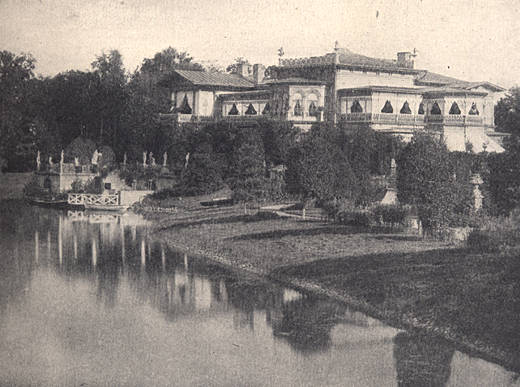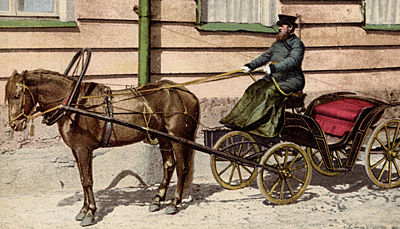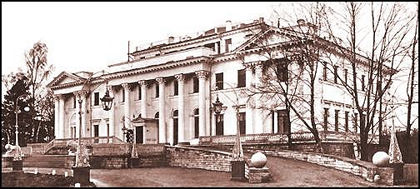   

Driving in Petersburg was a delightful experience for the traveller in 1900. Unlike today, when traffic jams, noise and noxious fumes make any car ride in petersburg a grimy misery, the horse draw cabs provided a leisurely way to get from one place to another. Americans liked the low and comfortable cabs with their huge black horses and enormous bearded drivers. Some cabs looked deceptively insubstantial to potential customers. One of them - called a "Decollettée Droski" - was especially favored by romantic couples because it's low back required a man to place his arm around the waist of his companion for protection.  Above: A Decollettée Droski.
In the summer a popular destination for drives were "the Islands" a group of 40 isles where wealthy and aristocratic Petersburgers had built palaces, parks and summer villas. It was easy to get there from the heart of the city; one could travel by cab or take little steamers through the archipelago. The final destination of many was the very tip of Yelagin Island and the romantic "Strielka" which looked out over the gulf of Finland. During White Nights in late June carriages paused to watch the midnight sun dip slowly below the horizon and the glinting surface of the Gulf.  Above: The garden facade of Yelagin Palace.
Yelagin Palace was the chief monument on the island that gave the building it's name. In 1900 it was the home of the Dowager Empress Marie. The Dowager Empress had many palaces in the Petersburg area. Beside Yelagin she lived at the Anichkov Palace on Nevsky Prospect in the city, at Alexandria-Peterhof in the Cottage Palace and also on the estate of Gatchina south of the city. Marie was formerly a Danish princess named Dagmar. Like other Protestant brides of Russian Tsars she changed her name when she received into the Orthodox Church. At first Marie had been engaged to Alexander II's oldest son, Nicholas. When he died she ended up marrying his younger brother, Alexander - who later became Tsar. Marie was also the sister of Queen Alexandra of England, who was married to Edward VIII. When the revolution broke out Marie was staying with her youngest daughter in the Mariinskii Palace. News about the tragic events concerning Nicholas II and his forced abdication from the throne reached Kiev quickly. In spite of the uncertain conditions on the railroads and spreading anarchic violence Marie took her private train and her son-in-law, Alexander, to Mogilev and Army Headquarters, where the Tsar had returned after being turned away from his destination of Tsarskoe Selo. Marie's short visit to her ill-fated son was the last time either of them saw each other. As for herself, Marie eventually found herself in relative safety of the Crimea locked up by revolutionary sailors in a walled Romanov villa. After a series of harrowing events - and a short German occupation of the Crimea - Maria was convinced by her daughters to board a British cruiser in 1920 that took her to Western Europe and exile. Marie died in 1928 in the land of her birth, Denmark.
The Yelagin Palace was built by Alexander I for his mother, Maria Feodorovna. It was designed by the architect, Carlo Rossi, who also designed the Michael Palace in Petersburg some years later. The building of the palace cost 1.3 million rubles and the work took four years to complete in June 1822. The palace was much loved by the people of the city for it's noble proportions, idyllic gardens and picturesque island setting.
Next photograph: The Garden of an Island Villa
For a small map of the St. Petersburg area click here.
To see a large map of the center
of St. Petersburg go here.
Comments on the website should be sent to Bob
Atchison. |
 |
|

